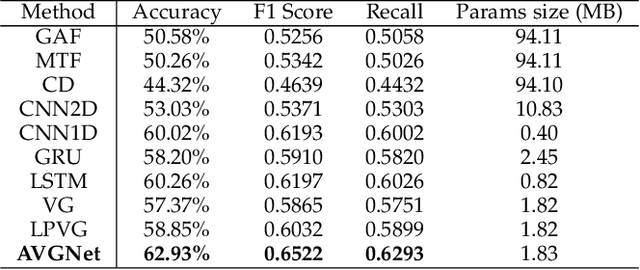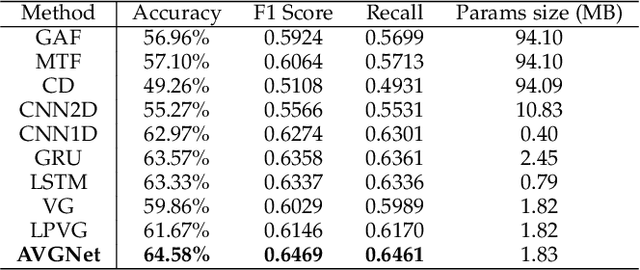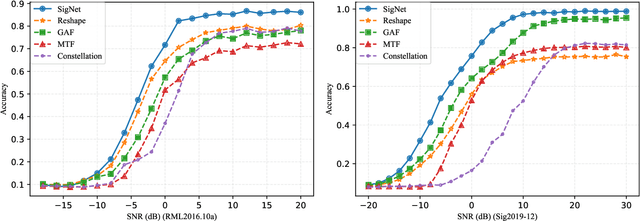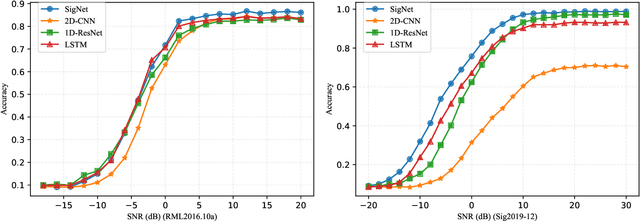Kunfeng Qiu
Augmenting Radio Signals with Wavelet Transform for Deep Learning-Based Modulation Recognition
Nov 07, 2023Abstract:The use of deep learning for radio modulation recognition has become prevalent in recent years. This approach automatically extracts high-dimensional features from large datasets, facilitating the accurate classification of modulation schemes. However, in real-world scenarios, it may not be feasible to gather sufficient training data in advance. Data augmentation is a method used to increase the diversity and quantity of training dataset and to reduce data sparsity and imbalance. In this paper, we propose data augmentation methods that involve replacing detail coefficients decomposed by discrete wavelet transform for reconstructing to generate new samples and expand the training set. Different generation methods are used to generate replacement sequences. Simulation results indicate that our proposed methods significantly outperform the other augmentation methods.
Adaptive Visibility Graph Neural Network and its Application in Modulation Classification
Jun 16, 2021



Abstract:Our digital world is full of time series and graphs which capture the various aspects of many complex systems. Traditionally, there are respective methods in processing these two different types of data, e.g., Recurrent Neural Network (RNN) and Graph Neural Network (GNN), while in recent years, time series could be mapped to graphs by using the techniques such as Visibility Graph (VG), so that researchers can use graph algorithms to mine the knowledge in time series. Such mapping methods establish a bridge between time series and graphs, and have high potential to facilitate the analysis of various real-world time series. However, the VG method and its variants are just based on fixed rules and thus lack of flexibility, largely limiting their application in reality. In this paper, we propose an Adaptive Visibility Graph (AVG) algorithm that can adaptively map time series into graphs, based on which we further establish an end-to-end classification framework AVGNet, by utilizing GNN model DiffPool as the classifier. We then adopt AVGNet for radio signal modulation classification which is an important task in the field of wireless communication. The simulations validate that AVGNet outperforms a series of advanced deep learning methods, achieving the state-of-the-art performance in this task.
SigNet: An Advanced Deep Learning Framework for Radio Signal Classification
Oct 28, 2020



Abstract:Deep learning methods achieve great success in many areas due to their powerful feature extraction capabilities and end-to-end training mechanism, and recently they are also introduced for radio signal modulation classification. In this paper, we propose a novel deep learning framework called SigNet, where a signal-to-matrix (S2M) operator is adopted to convert the original signal into a square matrix first and is co-trained with a follow-up CNN architecture for classification. This model is further accelerated by integrating 1D convolution operators, leading to the upgraded model SigNet2.0. The experiments on two signal datasets show that both SigNet and SigNet2.0 outperform a number of well-known baselines, achieving the state-of-the-art performance. Notably, they obtain significantly higher accuracy than 1D-ResNet and 2D-CNN (at most increasing 70.5\%), while much faster than LSTM (at most saving 88.0\% training time). More interestingly, our proposed models behave extremely well in few-shot learning when a small training data set is provided. They can achieve a relatively high accuracy even when 1\% training data are kept, while other baseline models may lose their effectiveness much more quickly as the datasets get smaller. Such result suggests that SigNet/SigNet2.0 could be extremely useful in the situations where labeled signal data are difficult to obtain.
 Add to Chrome
Add to Chrome Add to Firefox
Add to Firefox Add to Edge
Add to Edge